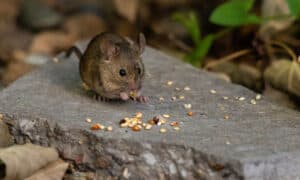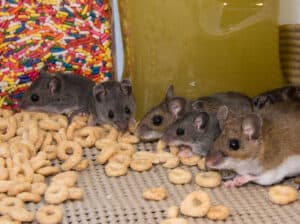There are many similarities between the echidna vs porcupine, yet each has its own set of unique qualities. Echidnas and porcupines are not members of the same family. Monotremata includes echidnas, sometimes known as spiny anteaters, and Tachyglossidae is the family in which they reside. The rodent Order Rodentia includes the spine-covered mammal known as the porcupine. We’ll look at eight more important differences between them in this article.
Echidna vs Porcupine: A Comparison
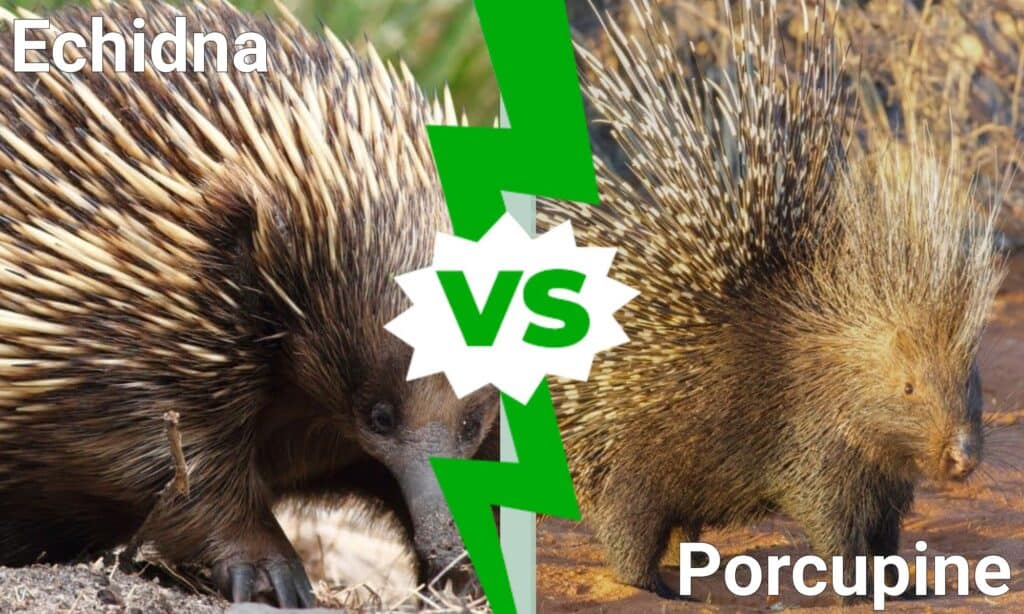
| Key Differences | Echidna | Porcupine |
| Size | 18 – 34 Inches (Includes Tail) 5.5 – 22 lbs. | 33 – 46 Inches (Includes Tail) 12 – 35 lbs. |
| Fur / Coat | 2 Layers, Barbless Spines on Outer Layer; Honey, Brown, Black | 3 Layers, Sharp Quills on Outer Layer; Dark Fur / Yellowish Tips |
| Location | New Guinea and Australia | Asia, Europe, Africa, The Americas |
| Temperament | Mostly Diurnal, Non-Territorial, Solitary | Mostly Nocturnal, Slow-Moving, Family Oriented |
| Domestication | Prohibited | Possible, but Not Ideal |
| danger Level | Non-Poisonous, Spines Could Inflict Harm | Non-Poisonous, Quills Can Get Stuck In Skin |
| Conservation Status | Long-Beak is Endangered | Not Endangered, Poached in SE Asia |
| Life Expectancy | 10 – 40 Years | 5 – 10+ Years |
Key Differences between Echidna vs Porcupine
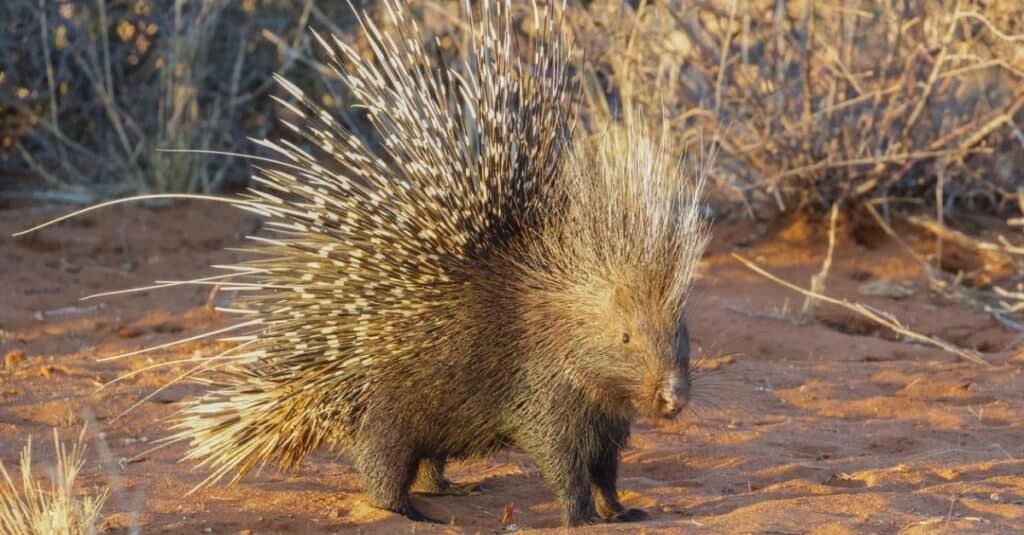
The Porcupine is not endangered, but some species of Echidna are.
©iStock.com/Pedro Ferreira do Amaral
The Echidna and Porcupine differ in a myriad of areas. The life expectancy of the Echidna is much longer compared to the lifespan of the Porcupine. Additionally, the Porcupine is not endangered, but some species of Echidna are. Both the Echidna and the Porcupine live in different regions and climates. Finally, the Porcupine has sharp quills, while the Echidna has barbless spines.
Let’s take a look at these differences in more detail now.
Appearance
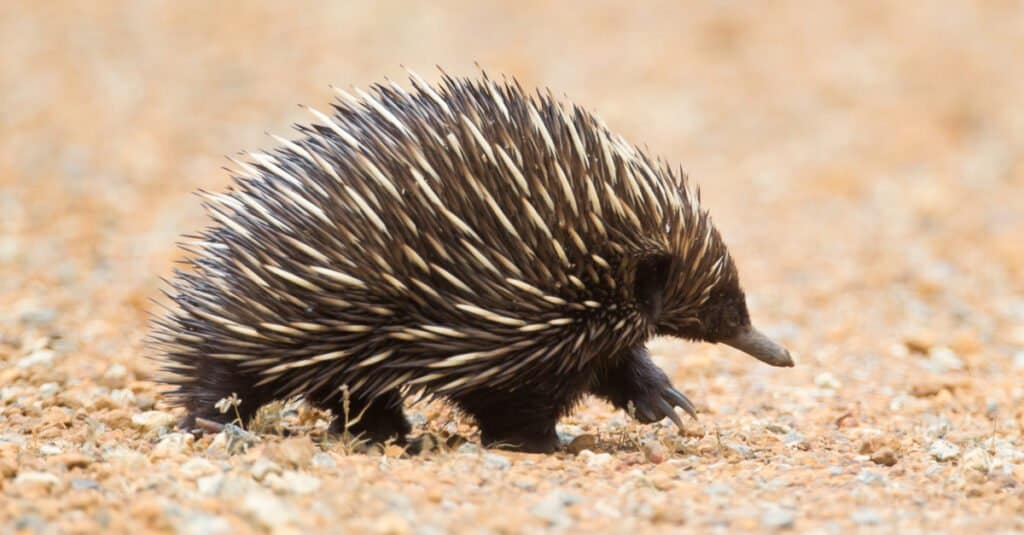
Both the Echidna and the Porcupine live in different regions and climates.
©Jukka Jantunen/Shutterstock.com
An echidna has short, strong limbs which are suited for scraping and digging in the dirt. Five flattened claws on the front foot are used to dig through forest litter and tear through wood and termite mounds. When the animal burrows, the hindfoot help push the soil away. The porcupine is a slow-moving, medium-sized mammal with impaired eyesight that relies on its hearing and scent, as well as its quills, to avoid predators.
Echidna vs Porcupine: Size
It is possible for an echidna to grow to 18 to 34 inches long and weigh 5.5 to 22 pounds. Their spines can grow up to two inches long. The ability to climb trees is a result of the porcupines’ strong, short legs and hairless feet soles. Males are much larger than females.
The adult weight of a porcupine ranges from 12 to 35 pounds. 25 to 36 inches is the typical length of the body and head; 8 to 10 inches is the typical length of the tail.
Echidna vs Porcupine: Fur / Coat
Porcupines have an undercoat, guard hairs, and hollow, pointy quills. Their quills are a type of modified hair used to strike predators. A porcupine’s silky hair is paired with sharp quills on its back, sides, and tail. A healthy porcupine can have up to 30,000 quills. When a porcupine is threatened, these quills lie flat before jumping to attention. When touched, the quills easily separate from the porcupines’ bodies. Their guard hairs are white or yellow with dark underfur. The quills of an adult porcupine often turn yellow.
Echidnas have spines and coarse hair. The spines are modified hairs made of keratin, the same protein found in claws, nails, and horn sheaths. The spines cover the back and sides of the short-beaked echidna, obscuring its dark fur. There is less fur and more spines on long-beaked echidnas. There are regular silky hairs between the spikes. Insulation is provided by the spines’ fur. They have a short tail and can be honey, reddish-brown or black.
Characteristics
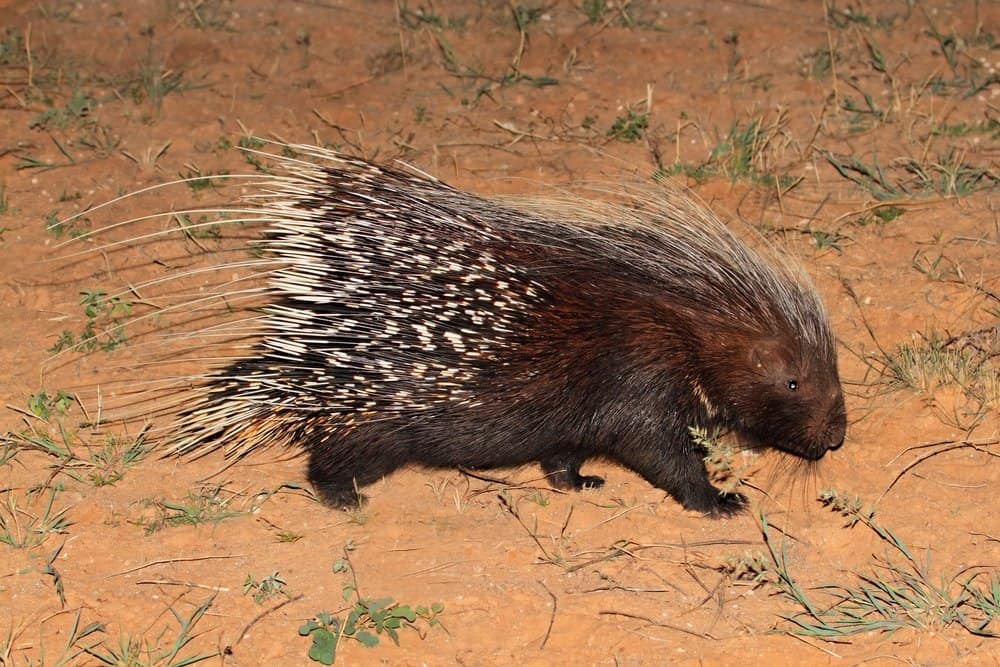
The Porcupine has sharp quills, while the Echidna has barbless spines.
©EcoPrint/Shutterstock.com
Echidna vs Porcupine: Location
All over Asia, Africa, Europe, and The Americas, there are porcupines to be found. Their habitats include forests, deserts, rocky hillocks, and hilltops. It’s common for new-world and old-world porcupines to seek different habitats.
All over New Guinea and Australia, echidnas can be found, notably on Flinders Island, King Island, Kangaroo Island, and Tasmania. These creatures tend to hide from harsh weather conditions by hiding in caves, dense vegetation, and cracks in rock formations.
Echidna vs Porcupine: Temperament
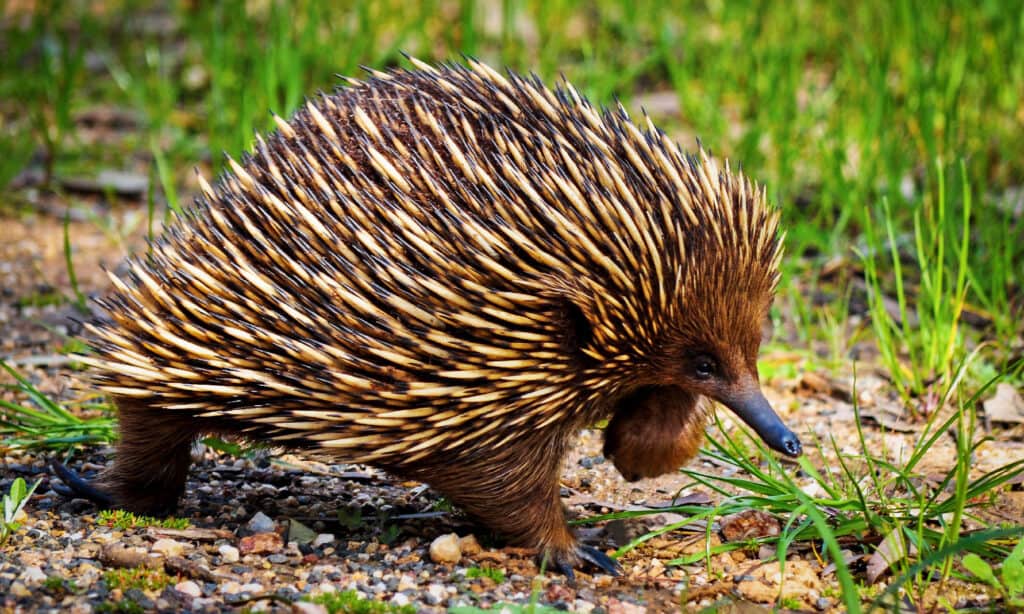
The Echidna lives in Australia, while Porcupines live in different habitats around the world.
©Vicki Cain/Shutterstock.com
Porcupines have poor vision and move slowly. These creatures are most active at night (nocturnal) and prefer to rest in trees on hot summer days. Porcupines have a home range of up to 200 acres, but they are not territorial. Five to six individuals make up a typical family of porcupines, and they tend to live in elaborate burrow systems.
One of the most unique characteristics of the echinoderm species is the fact that although they are solitary creatures, they are not territorial. They are usually willing to share their habitat with other individuals of the same species. In the summer, they go nocturnal to avoid the heat, yet they’re active during the day.
Echidna vs Porcupine: Domestication
In some states, porcupines are even legal to keep as pets. However, patience and the skill to handle this prickly rodent safely are required. Echidnas can be found in the wild in Australia, although it is illegal to keep them as pets.
Health Factors
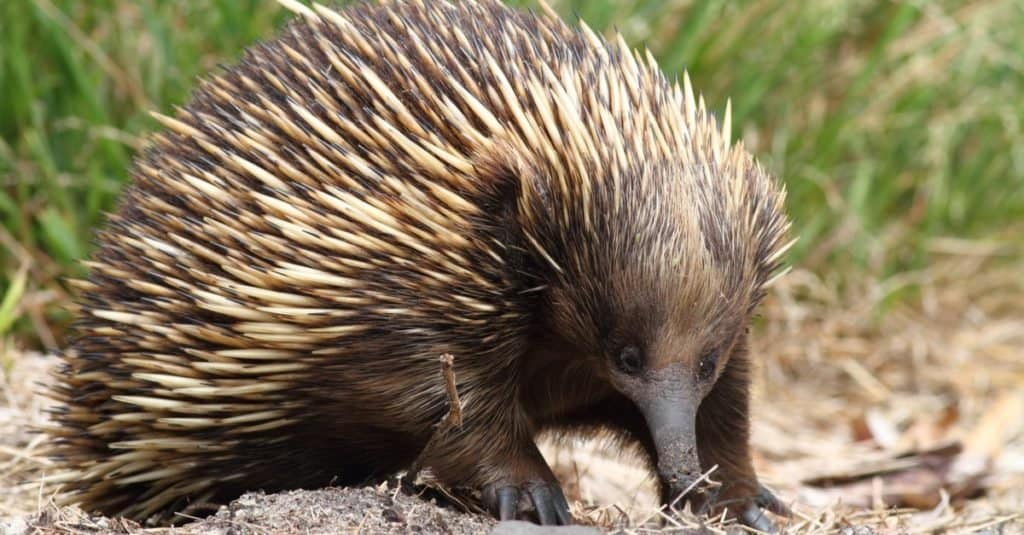
Porcupines are kept as pets in some regions, while Echidnas never are.
©Wayne Butterworth/Shutterstock.com
Echidna vs Porcupine: Danger Level
The long-beaked and short-beaked echidnas are not toxic. That doesn’t mean their spiky spines are harmless. Male echidnas create a waxy material at their rear foot spurs, but it is not venomous. It is not wise to try and handle or dig up Echidnas. You may be creating undue stress to the animal, possibly causing harm to yourself!
Porcupines rarely assault humans unless surprised. These animals fear humans more than anything. They will not bite you or your pets. However, they do have quills that can lodge into the skin. Porcupine quills are not toxic to people, but they should only be removed by a doctor or vet. Quills feature little barbs that are hard to see. If not responsibly managed, broken quills can embed and travel through the skin, causing infection and scarring.
Echidna vs Porcupine: Conservation Status
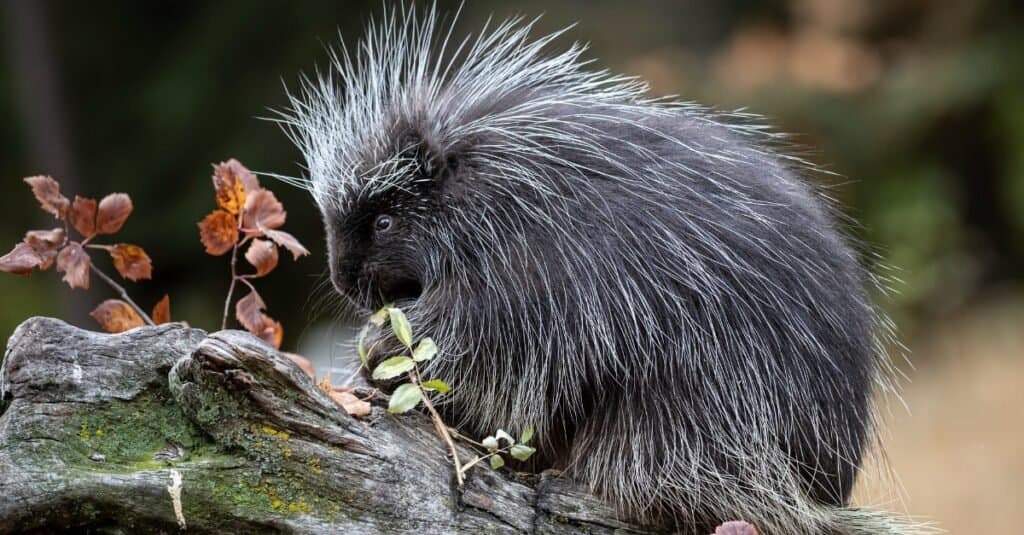
Some species of Echidna are endangered, while all Porcupines remain unthreatened.
©iStock.com/Carol Gray
The conservation status of the two echidna species varies greatly. Tachyglossus aculeatus, the short-beaked echidna, is not threatened in Australia or New Guinea. However, since 1998, long-beaked echidnas have been listed as endangered and are only in New Guinea. Studies are needed to determine the number of genetically different populations.
Although no species of the porcupine are currently listed as endangered, according to recognized wildlife trafficking experts, the little spiny porcupine may become extinct in Southeast Asia. This is due to the high demand for onion-shaped masses of undigested plant material in porcupines’ intestines called Bezoars. It is used in traditional Chinese medicine and is believed to help fight various types of cancer. If you are curious as to how much this costs, the average price is $151 per gram. That’s if you can even get your hands on it.
Echidna vs Porcupine: Life Expectancy
Although uncommon, an Echidna can live anywhere from 15 to 40 years in the wild, but the typical lifespan is closer to 10 years. A wild porcupine’s lifespan ranges from five to seven years. However, in captivity, porcupines have the potential to survive for up to ten years or more. In fact, a porcupine named Cooper lived for 32 years!
Wrapping Up Echidna vs Porcupine
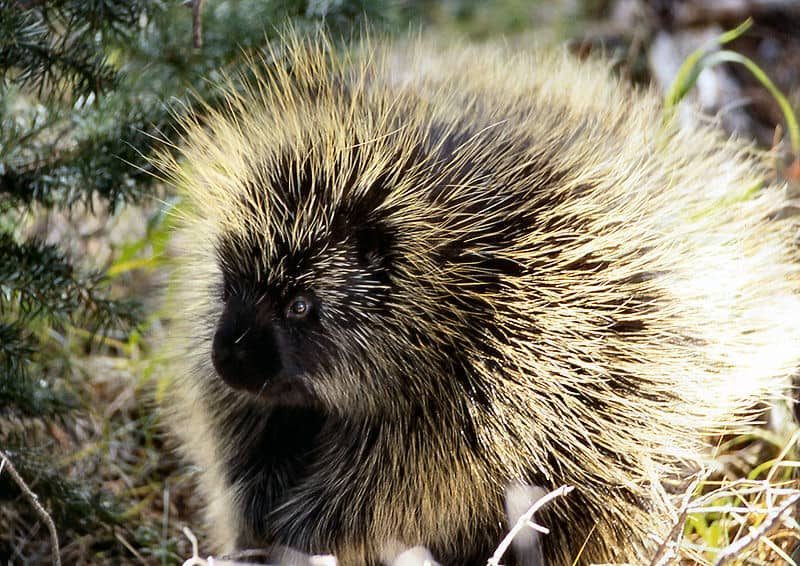
Porcupine’s spines range in length, whereas echidna’s spines are uniformly short and thin.
©National Park Service – Public Domain
As you can see, the Echidna and Porcupine have a lot of differences. Porcupines, for example, have spines that are sharper and stronger than echidnas. Porcupine’s spines range in length, whereas echidna’s spines are uniformly short and thin. Porcupines, on the other hand, are more widely distributed and have a greater variety of species. Echidnas live longer than porcupines in the wild, despite the latter’s bigger size. However, the simplest way to tell them apart is by their “nose.” The echidna has a long and narrow snout much like an anteater. The porcupine has a more typical-looking snout.
The photo featured at the top of this post is © iStock.com/Carol Gray
Thank you for reading! Have some feedback for us? Contact the AZ Animals editorial team.




